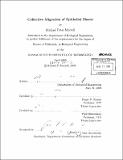Collective migration of epithelial sheets
Author(s)
Murrell, Michael Peter
DownloadFull printable version (21.56Mb)
Other Contributors
Massachusetts Institute of Technology. Dept. of Biological Engineering.
Advisor
Roger D. Kamm and Paul Matsudaira.
Terms of use
Metadata
Show full item recordAbstract
The varied movements of the epithelium play vital roles in the development and renewal of complex tissues, from the separation of tissues in the early embryo, to homeostasis in the adult. Their movement is intricately connected to their proper functioning as selective barriers of the intestinal mucosae, as well re-epithelialization in the healing of wounds. Yet, considering their ubiquity and relevance, the basic origin of the collective motion of sheets has eluded a clear and quantitative interpretation in physical terms, prohibited by the lack of understanding of the relationship between motility, cell-cell contact, and their mediation by the mechanical properties of the substratum to which they adhere. Therefore, within this context, this thesis defines the prerequisites for both equilibrium and non-equilibrium coordinated cell motion. The timescales and lengthscales of the in vitro migration of an epithelial monolayer were calculated and compared under imposed constraints designed to mimic various states of in vivo epithelia. These constraints include assays that recreate the wound response of the epithelium such as what is seen in the cornea and epidermis, by unequivocally separating the influence of free space from cell damage in the induction of coordinated motion. The motion of the epithelium was further explored by the generation of gradients that reproduce asymmetry in the capacity for cells to migrate, divide, or undergo apoptosis, such as what is found along the crypt-villus axis of the intestine. Finally, as the epithelium adheres and migrates against the basal lamina, a substrate of uncertain in vivo mechanical properties, we explored the contribution of substrate viscoelasticity to the dynamics of coordinated migration. Parameterized this way, multiple modes of motility emerge, each distinct dynamically, phenotypically, and in their dependence on cell-cell contact.
Description
Thesis (Ph. D.)--Massachusetts Institute of Technology, Dept. of Biological Engineering, 2009. Cataloged from PDF version of thesis. Includes bibliographical references (p. 223-234).
Date issued
2009Department
Massachusetts Institute of Technology. Department of Biological EngineeringPublisher
Massachusetts Institute of Technology
Keywords
Biological Engineering.